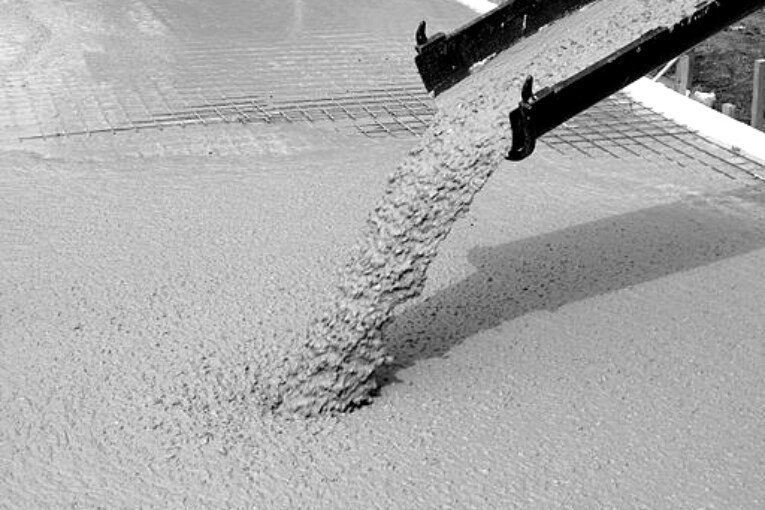
Plain concrete, commonly known as concrete, is an intimate mixture of binding material, fine aggregate, coarse aggregate and water. This can be easily moulded to desired shape and size before it looses plasticity and hardens. Plain concrete is strong in compression but very weak in tension.
The tensile property is introduced in concrete by inducting different materials and this attempt has given rise to RCC, RBC, PSC, FRC, cellular concrete and Ferro cement. In this chapter proportioning, mixing, curing, properties, tests and uses of plain concrete is dealt in detail. The other improved versions of concrete are explained and their special properties and uses are pointed out.
PLAIN CONCRETE
Major ingredients of concrete are:
1. Binding material (like cement, lime, polymer)
2. Fine aggregate (sand)
3. Coarse aggregates (crushed stone, jelly)
4. Water.
A small quantity of admixtures like air entraining agents, waterproofing agents, workability agents etc. may also be added to impart special properties to the plain concrete mixture. Depending upon the proportion of ingredient, strength of concrete varies.
It is possible to determine the proportion of the ingredients for a particular strength by mix design procedure. In the absence of mix design the ingredients are proportioned as 1:1:2, 1:1 ½ :3, 1:2:4, 1:3:6 and 1:4:8, which is the ratio of weights of cement to sand to coarse aggregate. In proportioning of concrete it is kept in mind that voids in coarse aggregates are filled with sand and the voids in sand are filled with cement paste.
Proportion of cement, sand and coarse aggregates in concrete
1:1:2 For machine foundation, footings for steel columns and concreting under water.
1:1 ½ : 3 Water tanks, shells and folded plates, for other water retaining structures.
1:2:4 Commonly used for reinforced concrete works like beams, slabs, tunnel lining, bridges
1:3:6 Piers, abutments, concrete walls, sill of windows, floors.
1:4:8 Mass concretes like dam, foundation course for walls, for making concrete blocks.
Functions of Various Ingredients
Cement is the binding material. After addition of water it hydrates and binds aggregates and the surrounding surfaces like stone and bricks. Generally richer mix (with more cement) gives more strength. Setting time starts after 30 minutes and ends after 6 hours. Hence concrete should be laid in its mould before 30 minutes of mixing of water and should not be subjected to any external forces till final setting takes place.
Coarse aggregate consists of crushed stones. It should be well graded and the stones should be of igneous origin. They should be clean, sharp, angular and hard. They give mass to the concrete and prevent shrinkage of cement. Fine aggregate consists of river sand. It prevents shrinkage of cement.
When surrounded by cement it gains mobility enters the voids in coarse aggregates and binding of ingredients takes place. It adds density to concrete, since it fills the voids. Denser the concrete higher is its strength. Water used for making concrete should be clean. It activates the hydration of cement and forms plastic mass. As it sets completely concrete becomes hard mass.
Water gives workability to concrete which means water makes it possible to mix the concrete with ease and place it in final position. More the water better is the workability. However excess water reduces the strength of concrete. To achieve required workability and at the same time good strength a water cement ratio of 0.4 to 0.45 is used, in case of machine mixing and water cement ratio of 0.5 to 0.6 is used for hand mixing.
Preparing and Placing of Concrete
The following steps are involved in the concreting:
1. Batching
2. Mixing
3. Transporting and placing and
4. Compacting.
1. Batching:
The measurement of materials for making concrete is known as batching. The
following two methods of batching is practiced:
(a) Volume batching
(b) Weight batching.
(a) Volume Batching:
In this method cement, sand and concrete are batched by volume. A gauge box is made with wooden plates, its volume being equal to that of one bag of cement. One bag of cement has volume of 35 litres. The required amount of sand and coarse aggregate is added by measuring on to the gauge box. The quantity of water required for making concrete is found after deciding water cement ratio.
For example, if water cement ratio is 0.5, for one bag of cement (50 kg), water required is 0.5 × 50 = 25 kg, which is equal to 25 litres. Suitable measure is used to select required quantity of water.Volume batching is not ideal method of batching. Wet sand has higher volume for the same weight of dry sand. It is called bulking of sand. Hence it upsets the calculated volume required.
(b) Weight Batching:
This is the recommended method of batching. A weighing platform is
used in the field to pick up correct proportion of sand and coarse aggregates. Large weigh batching plants have automatic weighing equipments.
2. Mixing:
To produce uniform and good concrete, it is necessary to mix cement, sand and
coarse aggregate, first in dry condition and then in wet condition after adding water.
The following methods are practiced:
(a) Hand Mixing
(b) Machine Mixing.
(a) Hand Mixing:
Required amount of coarse aggregate for a batch is weighed and is spread on an impervious platform. Then the sand required for the batch is spread over coarse aggregate. They are mixed in dry condition by overturning the mix with shovels. Then the cement required for the batch is spread over the dry mix and mixed by shovels. After uniform texture is observed water is added gradually and mixing is continued. Full amount of water is added and mixing is completed when uniform colour and consistency is observed. The process of mixing is completed in 6–8 minutes of adding water. This method of mixing is not very good but for small works it is commonly adopted.
(b) Machine Mixing:
In large and important works machine mixing is preferred. Required quantities if sand and coarse aggregates are placed in the drum of the mixer. 4 to 5 rotations are made for dry mixing and then required quantity of cement is added and dry mixing is made with another 4 to 5 rotations. Water is gradually added and drum is rotated for 2 to 3 minutes during which period it makes about 50 rotations. At this stage uniform and homogeneous mix is obtained.
3. Transporting and Placing of Concrete.
After mixing concrete should be transported to the
final position. In small works it is transported in iron pans from hand to hand of a set of workers. Wheelbarrow and hand carts also may be employed. In large scale concreting chutes and belt conveyors or pipes with pumps are employed. In transporting care should be taken to see that segregation of aggregate from matrix of cement do not take place.Concrete is placed on form works. The form works should be cleaned and properly oiled. If concrete is to be placed for foundation, the soil bed should be compacted well and is made free from loose soil.Concrete should be dropped on its final position as closely as possible. If it is dropped from a height, the coarse aggregates fall early and then mortar matrix. This segregation results into weaker concrete.
4. Compaction of Concrete:
In the process of placing concrete, air is entrapped. The entrapped air reduces the strength of concrete up to 30%. Hence it is necessary to remove this entrapped air. This is achieved by compacting the concrete after placing it in its final position. Compaction can be carried out either by hand or with the help of vibrators.
(a) Hand Compaction:
In this method concrete is compacted by ramming, tamping, spading or
by slicing with tools. In intricate portions a pointed steel rod of 16 mm diameter and about a metre long is used for poking the concrete.
(b) Compaction by Vibrators:
Concrete can be compacted by using high frequency vibrators.
Vibration reduces the friction between the particles and set the motion of particles. As a result entrapped air is removed and the concrete is compacted. The use of vibrators reduces the compaction time. When vibrators are used for compaction, water cement ratio can be less, which also help in improving the strength of concrete. Vibration should be stopped as soon as cement paste is seen on the surface of concrete. Over vibration is not good for the concrete.
The following types of vibrators are commonly used in concreting:
(a) Needle or immersion vibrators
(b) Surface vibrators
(c) Form or shutter vibrators
(d) Vibrating tables.
Needle vibrators are used in concreting beams and columns. Surface vibrators and form vibrators are useful in concreting slabs. Vibrating tables are useful in preparing precast concrete elements.
Curing of Concrete
Curing may be defined as the process of maintaining satisfactory moisture and temperature conditions for freshly placed concrete for some specified time for proper hardening of concrete. Curing in the early ages of concrete is more important. Curing for 14 days is very important. Better to continue it for 7 to 14 days more. If curing is not done properly, the strength of concrete reduces. Cracks develop due shrinkage.
The durability of concrete structure reduces. The following curing methods are employed:
(a) Spraying of water
(b) Covering the surface with wet gunny bags, straw etc.
(c) Ponding
(d) Steam curing and
(e) Application of curing compounds.
(a) Spraying of water:
Walls, columns, plastered surfaces are cured by sprinkling water.
(b) Wet covering the surface:
Columns and other vertical surfaces may be cured by covering
the surfaces with wet gunny bags or straw.
(c) Ponding:
The horizontal surfaces like slab and floors are cured by stagnating the water to a
height of 25 to 50 mm by providing temporary small hunds with mortar.
(d) Steam curing:
In the manufacture of pre-fabricated concrete units steam is passed over the
units kept in closed chambers. It accelerates curing process, resulting into the reduction of curing period.
(e) Application of curing compounds:
Compounds like calcium chloride may be applied on the curing surface. The compound shows affinity to the moisture and retains it on the surface. It keeps the concrete surface wet for a long time.



Comments are closed